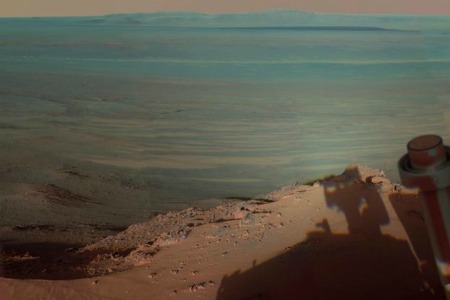
Mars rover Opportunity captures its own shadow on the rim of Endeavour Crater. Image credit NASA/JPL
I’m building up a smorgasborg of Martian images and news articles below …
(NASA/JPL) — “These findings show that the storage of reduced carbon molecules on Mars occurred throughout the planet’s history and might have been similar to processes that occurred on the ancient Earth,” said Andrew Steele, lead author of the paper and researcher from Carnegie. “Understanding the genesis of these non-biological, carbon-containing macromolecules on Mars is crucial for developing future missions to detect evidence of life on our neighboring planet.”
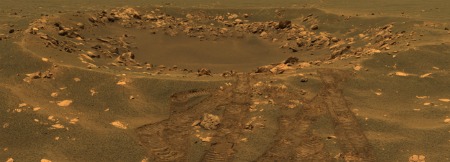
Fram crater about 25 feet in diameter as seen by Opportunity on April 24, 2004. One of many thousands of medium sized celestial bullet wounds on the surface of Mars
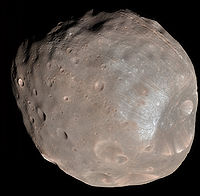

Dark Phobos left and lighter Deimos right. Tiny captured asteroid moons a few miles across as seen by the MRO. With super low gravity and close proximity above the Red Planet, these are two natural future Martian spacebases.

Teamwork: The Mars Rover team celebrates the first signal from Spirit, indicating the rover's safe arrival at Gusev Crater on Mars.
In 1976 two Viking spacecraft landed on Mars and sent back the first surface images. Just last month one scientists concluded they may have found more than they bargained for:
(Discovery News) — “The ultimate proof is to take a video of a Martian bacteria. They should send a microscope — watch the bacteria move,” Miller said. “On the basis of what we’ve done so far, I’d say I’m 99 percent sure there’s life there,” he added. … Miller’s confidence stems in part from a new study that re-analyzed results from a life-detection experiment conducted by NASA’s Viking Mars robots in 1976.
Back when Phoenix first landed on Mars’ south pole and sent back the first clear images just a few minutes later, my friend and DKos colleague Mark Sumner, who writes as DevilsTower and plays a geologist in real life, took one look at the images like the one below and said “That’s got to be frost heaving.” For a precious few moments Mark and I knew something about the universe that very few people knew, that Mars had large quantities of ice just under the polar surface that had undergone some kind of periodic melting and freezing, and it felt really cool to know it early like that! Just a few hours later, NASA/JPL announced these polygon like patterns were indeed strong evidence for water-ice just under the surface. Phoenix soon confirmed this by direct observation.
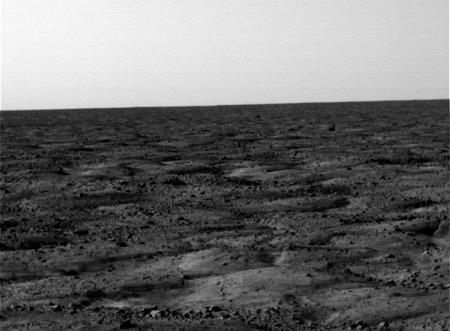

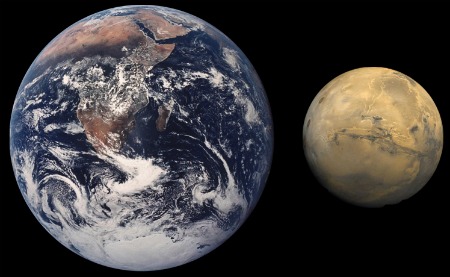

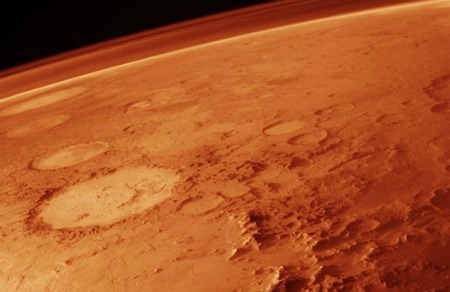

Faaake, that’s clearly Utah (/conspiracist)
Sending people your way Katherine, you shoulda played ball …
This! This is why I’m a humanist. No gods did this – we did it all on our own. We certainly have some serious problems, and nothing is for sure, but every time I see a photograph like this I gain back a little bit of hope for our species.
XD Thanks for making me giggle, Stephen.
I know why they do it — to increase contrast and make subtle differences more visible — but damn it all, Mars does not have entire valleys of turquoise blue! When I look at images from the Red Planet, I want to see a red planet!
Beatiful compilation. Cheers! :-)
If you go to the Wiki site for that last picture of the patterned ground it says it was taken on Devon Island in the Canadian Arctic, on Earth. Not on Mars.
I think I fixed it, I meant to do a stack there but got confused in edit, thanks! BTW, I remember when those images were first streaming in, Mark Sumner, aka DevilsTower at Dkos is a geologist in real life. He took one look at it and said “That’s frost heaving”. That’s when we all knew there would probably be water hiding under the surface.
Fantastic! Absolutely spectacular. I wanna go there.
Ohnoes, sadface you added something about Spirit T^T
Rest in peace little robot friend. Maybe we’ll find you again and build a city around you.